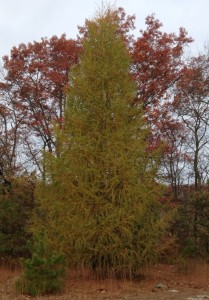Hello fellow readers, Seeing evergreens drop needles often triggers concern. It’s kind of like an abundance of hairs in your shower drain. Andrea of Morristown, NJ, asked what was going on with her white pines yellowing. It’s called Fall Needle Drop “of renewal” (my addition :^).
All trees and shrubs renew their foliage every year.
While leaves of deciduous plants live for one growing season, evergreen foliage, despite its name, does not live forever. As new growth emerges in the spring, the previous year’s growth becomes shaded. During fall, the inner or older needles die and fall off.

Normal White Pine Needle Drop
Pine trees hold their needles typically for 2 to 5 years, depending on the species. Spruce trees generally hold onto theirs for 5 to 7 years. Hence every autumn, some evergreen needles fall. Sometimes this natural process goes unnoticed because only the innermost needles are affected.
Eastern White Pine (Pinus strobus) are not shy about disrobing. They only hold needles for two years and have an open structure with less growth at the tip of their branches to hide the needles as they undress.

European Larch (Larix decidua) Gold Fall Color
Stress factors can add to Fall Needle Drop.
While needle drop is natural (like some hair loss), stress factors such as drought, herbicide injury, root damage, and insect or disease damage can intensify the loss. Regular needle drop occurs only on the inner needles. If entire branches or new needles at the tips of branches are dying, or if needles turn yellow and drop at other times of the year, something else is happening, such as a fungal disease, spider mites, aphids, or other pests. Reach out to an arborist to advise you on the best course of action.
White Pine Decline has recently been an issue, though it’s mysterious what causes it. Authorities have found that affected trees have meager root systems likely caused by several soil fungi not yet explicitly identified. It’s a slow process and not considered contagious, unlike Pine Wilt caused by a nematode which typically kills a tree in one season, turning off-green to brown quickly. If your tree has Pine Wilt, remove it before the surrounding white pines are affected.
If your tree has White Pine Decline, though, there’s no rush to remove it as it won’t infect other trees. However, the only treatment is prevention. Assuring proper irrigation and soil pH (white pines prefer acidic soil) will help trees fight off the fungi before its impacted.

Arborvitaes shed branchlets each year though this one may be showing the stress of being newly planted.
Arborvitaes shed branchlets in the fall.
Marianne, from Knowlton Township, asked about her fifty-foot-tall Green Giant Arborvitae (Thuja standishii x plicata). “They were glorious in the summer but now look terminal with orange inside.” I noticed the lineup at Footbridge Park in the same condition and surmised it was from the summer drought, but the mature trees will rebound.
Arborvitaes shed branchlets, first turning yellow or orange, then brown. And the brown branchlets stay on the tree for some time before dropping. There’s always normal shedding of foliage, but drought impacts arborvitaes more than other trees. If your tree is overly brown, check with an arborist to see if something more significant is happening.
Some conifers shed all their needles each year.

European Larch (Larix decidua) Gold Fall Color
Some conifers shed all their needles every year, such as European larch (Larix decidua), Dawn Redwood (Metasequoia glyptostroboides), and Bald Cypress (Taxodium distichum), so don’t think something is wrong when they go bald. And enjoy their stunning golden and bronze colors, making a magnificent addition to the landscape. Besides, baldness can be very attractive. Garden Dilemmas? AskMaryStone@gmail.com and your favorite Podcast App.
An excerpt from the Podcast version of the story (link below)

Some conifers shed all their needles each year Baldness can be very attractive :^). Thanks for posing your handsome heads, Curt and Morris.
When you think about it, shedding leaves and needles is much like how our cells renew themselves. Our skin and our organs are continually refurbishing. We’re not the same body now as we were ten years ago or even a week ago. There’s hope in the renewal of cells – isn’t there? Especially when struggling with health issues or lameness like my shoulders, which have given me grief from the repetitive motion of lifting plants off trucks. I’m sure it has nothing to do with aging, right? (smile)
But aging changes also come with renewal, like the leaves on trees and evergreen needles. They turn colors and fall to serve their new purpose on earth, nourishing it with all they gain from gathering energy from the sun during the season of growth. We are always in transition. It’s part of what we can count on in this life – change. May we find comfort in the cycles of the seasons.
Enjoy more of the story in Episode 79 of the Garden Dilemmas Podcast.
Link to related story – Leaf Mold – Better than Mulch
More about Pine Wilt vs. White Pine Decline


